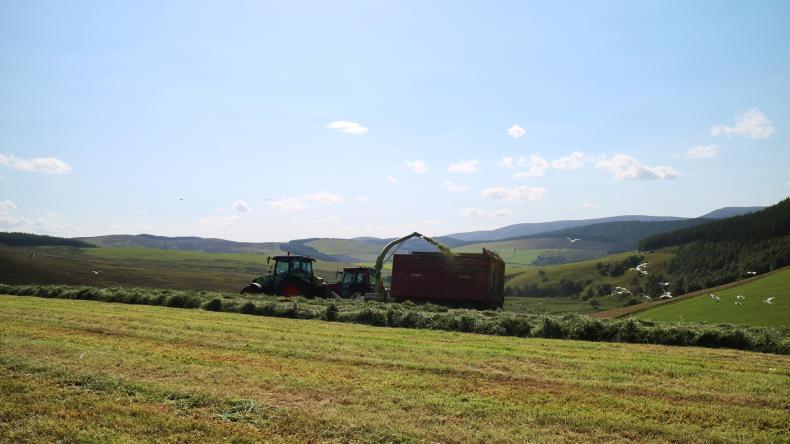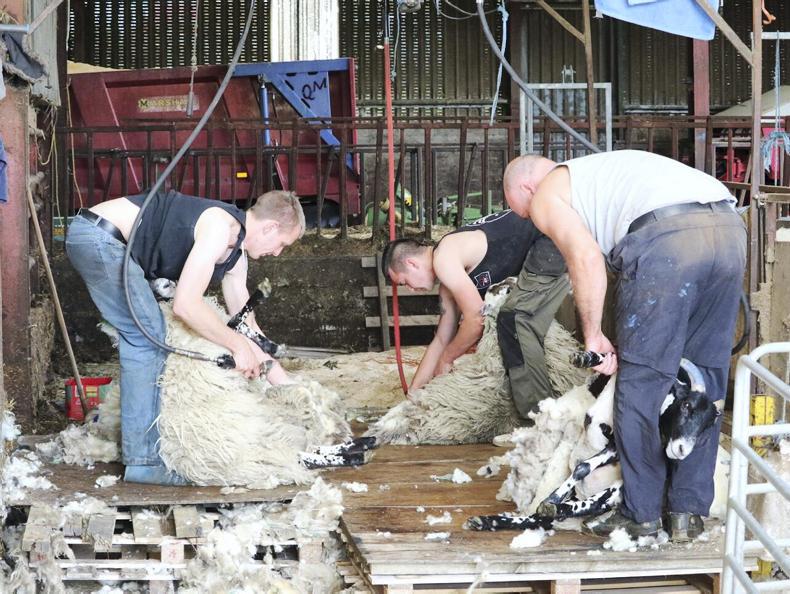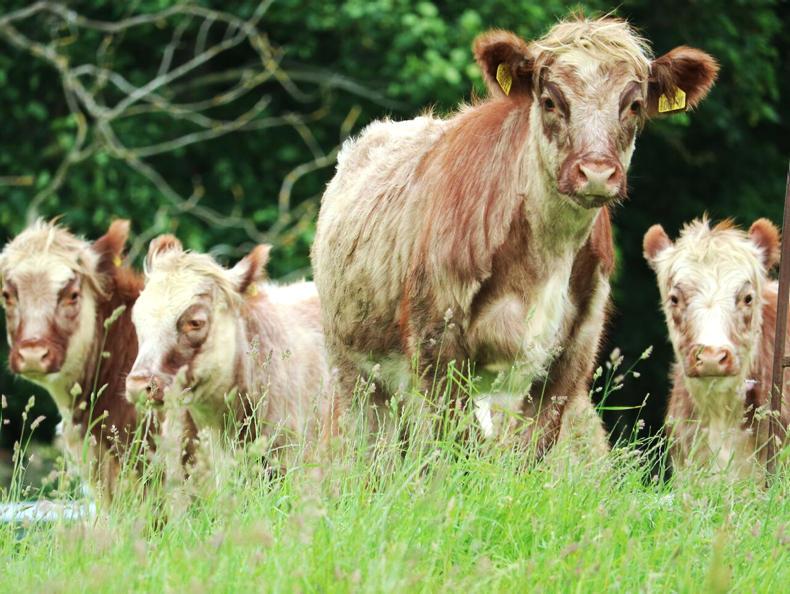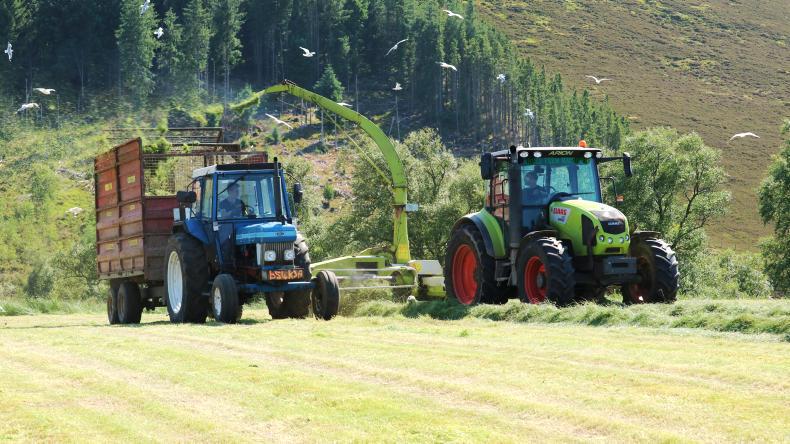Andrew Duffus, with his wife Debbie and three sons Sam, Ben and Max, farms just outside Tomintoul in the Cairngorm national park. They run 94 cows split between spring and autumn calving.
Cows are mated to Charolais for store cattle, Simmental for breeding replacements and a Limousin for heifers. Young stock are all sold store between 12 and 15 months old.
The sheep enterprise consists of 640 ewes in total, 400 of which are the hill flock of Blackface ewes that produce mules for the 240 in-bye flock. The mules are then mated to Texel tups, with some lambs sold fat and the rest store.
Andrew Duffus
No matter how good a spell of weather has been, we could always do with that little bit more. We had the bulk of the silage in last week, but with just 10 acres or so to go late Wednesday night, the storm that had been sweeping up the country reached us in the early hours of Thursday morning. It was too wet to pick it up on Thursday, but we got back to it again Saturday afternoon.
Overall, it went very well. Conditions had been nearly perfect. Over 72 acres of the 82 in total was mowed and picked without a drop of rain. I was really pleased with the crops; they were as good as I have seen here in a lot of years. It should be decent quality too, as the ewes lambed in these parks and they were only shut off for silage in mid-May.
There are two fields side by side on the home farm; one got lime and is a lovely deep green while the one beside it didn’t get lime and looks a sickly yellow
I think the lime we spread early in the year has helped. There are two fields side by side on the home farm; one got lime and is a lovely deep green while the one beside it didn’t get lime and looks a sickly yellow. We will need to spread more in the autumn on the ground that hasn’t had any yet.
We had already made just short of 300 bales off 30 acres on the outfarm at Glenconglas on 18 June. This was a lot earlier than we would usually make silage on the farm. However, with all the young stock wintered on the outfarm, we’re hoping that better-quality silage will help reduce the amount of barley needed over the winter.

Three weeks ago, we weaned all the autumn calves. Other years we might have left them a little longer, but we were starting to get a bit tight for grass. Since that though, grass growth has kicked on again and we’ve a bank of grass built up ahead of us.
The cows were put to the hill to dry off and hopefully lose a little bit of condition as they are really fit this year. There are 47 autumn cows that will start calving from mid-September onwards. It should be a fairly compact calving, as we have been working on tightening the calving spread over the last few years. The majority will calve in nine weeks.
Prior to the silage, we had started clipping some ewes. We started with the hoggs; there was 140 of them. It’s a family affair; Max, Sam and I were clipping and dad was rolling and bagging the wool.
They were well ready for clipping. The rise was on the fleece. We need to get back to the rest now in the coming days. We usually do around 150 or so a day. The most time-consuming part of the job is rounding them up off the hill. We clipped the 140 in about four hours on the last day.

While this is supposed to be the quiet time on the farm, there is still no shortage of work. We spent a few days spreading pot ale on all the silage ground to get the grass growing again. The plan is to wean the lambs on to the after grass once it’s ready for grazing.
One of the things that came up in our farm review and farm plan with Declan and Robert was the need to lift output on the farm. We need to spread our costs over more kilos of output sold every year. To address this, we have decided to create a small hill cow herd. The first five heifers came home a couple of week ago. They are Highland-cross Shorthorn heifers just over a year old. They will be fit for bulling next summer.
While it will be a couple of years before these ladies start paying their way, they are coming home at decent money and the cost of keeping them will be next to nothing, as they will be on the hill most of the year. They will actually improve the hill for the ewes by breaking up some of the old grass.

We’re undecided just yet as to what bull to put with them. Ideally, any heifer calves would come in as replacements for the main herd, giving us a constant supply of mid-sized functional cows.
That was something that stood out to me when we weighed all the autumn cows and calves going to grass. There was a difference of 216kg between the lightest and heaviest cow. However, the heavier cows didn’t have the heaviest calves. When we looked at the figures, the bigger cows’ calves were on average 24kg lighter than the smaller cows’ calves.
So the heavier cows are eating more to produce less. When you take the cost of the extra feed to keep the heavier cow, plus the loss in potential kilos of their calves, there was a difference of £150/cow between the two groups.
Set a date to pull the bull
For spring herds calving from mid-February, bulls will now be with the cows for close to 11 weeks. In order to keep a tight calving spread, bulls should be removed in the next week to 10 days.
The same goes for those that are later calving. Count up the number of weeks breeding already completed and mark the date in the calendar to remove the bulls. Even with a 12-week calving spread, there will be 84 days before the first and last born calves.
At this age, an average daily gain of 1.3kg/day should be attainable. This equates to a liveweight difference of 109kg between first and last born calves. Valued at £2.35/kg, that’s a difference of £257 between the two.
Often the excuse is that there is nowhere to put the bull away from the cows. Plan ahead and get something sorted over the next week. A well-fenced paddock, a field away from cows and heifers on an outfarm or perhaps housing is the best option. If the bull is to be culled, take advantage of the current beef price and get him sold.
Read more
More reports from the Farm Profit Programme
Andrew Duffus, with his wife Debbie and three sons Sam, Ben and Max, farms just outside Tomintoul in the Cairngorm national park. They run 94 cows split between spring and autumn calving.
Cows are mated to Charolais for store cattle, Simmental for breeding replacements and a Limousin for heifers. Young stock are all sold store between 12 and 15 months old.
The sheep enterprise consists of 640 ewes in total, 400 of which are the hill flock of Blackface ewes that produce mules for the 240 in-bye flock. The mules are then mated to Texel tups, with some lambs sold fat and the rest store.
Andrew Duffus
No matter how good a spell of weather has been, we could always do with that little bit more. We had the bulk of the silage in last week, but with just 10 acres or so to go late Wednesday night, the storm that had been sweeping up the country reached us in the early hours of Thursday morning. It was too wet to pick it up on Thursday, but we got back to it again Saturday afternoon.
Overall, it went very well. Conditions had been nearly perfect. Over 72 acres of the 82 in total was mowed and picked without a drop of rain. I was really pleased with the crops; they were as good as I have seen here in a lot of years. It should be decent quality too, as the ewes lambed in these parks and they were only shut off for silage in mid-May.
There are two fields side by side on the home farm; one got lime and is a lovely deep green while the one beside it didn’t get lime and looks a sickly yellow
I think the lime we spread early in the year has helped. There are two fields side by side on the home farm; one got lime and is a lovely deep green while the one beside it didn’t get lime and looks a sickly yellow. We will need to spread more in the autumn on the ground that hasn’t had any yet.
We had already made just short of 300 bales off 30 acres on the outfarm at Glenconglas on 18 June. This was a lot earlier than we would usually make silage on the farm. However, with all the young stock wintered on the outfarm, we’re hoping that better-quality silage will help reduce the amount of barley needed over the winter.

Three weeks ago, we weaned all the autumn calves. Other years we might have left them a little longer, but we were starting to get a bit tight for grass. Since that though, grass growth has kicked on again and we’ve a bank of grass built up ahead of us.
The cows were put to the hill to dry off and hopefully lose a little bit of condition as they are really fit this year. There are 47 autumn cows that will start calving from mid-September onwards. It should be a fairly compact calving, as we have been working on tightening the calving spread over the last few years. The majority will calve in nine weeks.
Prior to the silage, we had started clipping some ewes. We started with the hoggs; there was 140 of them. It’s a family affair; Max, Sam and I were clipping and dad was rolling and bagging the wool.
They were well ready for clipping. The rise was on the fleece. We need to get back to the rest now in the coming days. We usually do around 150 or so a day. The most time-consuming part of the job is rounding them up off the hill. We clipped the 140 in about four hours on the last day.

While this is supposed to be the quiet time on the farm, there is still no shortage of work. We spent a few days spreading pot ale on all the silage ground to get the grass growing again. The plan is to wean the lambs on to the after grass once it’s ready for grazing.
One of the things that came up in our farm review and farm plan with Declan and Robert was the need to lift output on the farm. We need to spread our costs over more kilos of output sold every year. To address this, we have decided to create a small hill cow herd. The first five heifers came home a couple of week ago. They are Highland-cross Shorthorn heifers just over a year old. They will be fit for bulling next summer.
While it will be a couple of years before these ladies start paying their way, they are coming home at decent money and the cost of keeping them will be next to nothing, as they will be on the hill most of the year. They will actually improve the hill for the ewes by breaking up some of the old grass.

We’re undecided just yet as to what bull to put with them. Ideally, any heifer calves would come in as replacements for the main herd, giving us a constant supply of mid-sized functional cows.
That was something that stood out to me when we weighed all the autumn cows and calves going to grass. There was a difference of 216kg between the lightest and heaviest cow. However, the heavier cows didn’t have the heaviest calves. When we looked at the figures, the bigger cows’ calves were on average 24kg lighter than the smaller cows’ calves.
So the heavier cows are eating more to produce less. When you take the cost of the extra feed to keep the heavier cow, plus the loss in potential kilos of their calves, there was a difference of £150/cow between the two groups.
Set a date to pull the bull
For spring herds calving from mid-February, bulls will now be with the cows for close to 11 weeks. In order to keep a tight calving spread, bulls should be removed in the next week to 10 days.
The same goes for those that are later calving. Count up the number of weeks breeding already completed and mark the date in the calendar to remove the bulls. Even with a 12-week calving spread, there will be 84 days before the first and last born calves.
At this age, an average daily gain of 1.3kg/day should be attainable. This equates to a liveweight difference of 109kg between first and last born calves. Valued at £2.35/kg, that’s a difference of £257 between the two.
Often the excuse is that there is nowhere to put the bull away from the cows. Plan ahead and get something sorted over the next week. A well-fenced paddock, a field away from cows and heifers on an outfarm or perhaps housing is the best option. If the bull is to be culled, take advantage of the current beef price and get him sold.
Read more
More reports from the Farm Profit Programme









 This is a subscriber-only article
This is a subscriber-only article














SHARING OPTIONS: